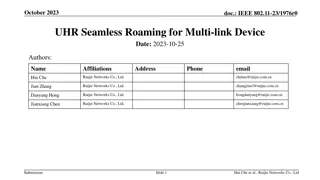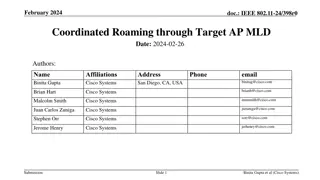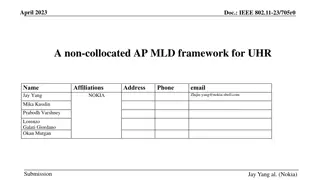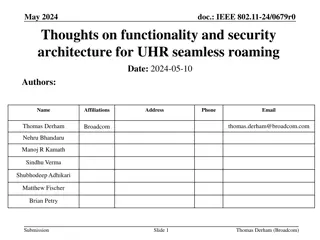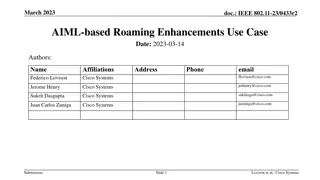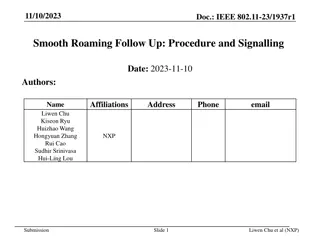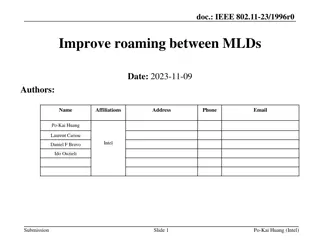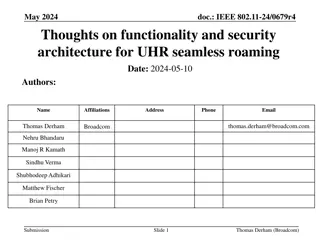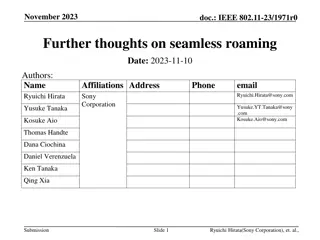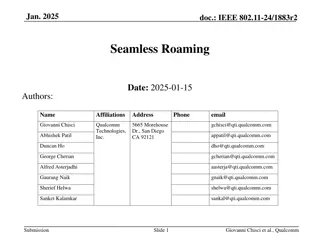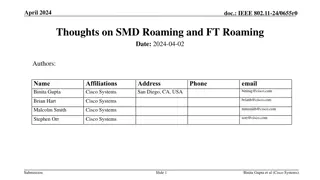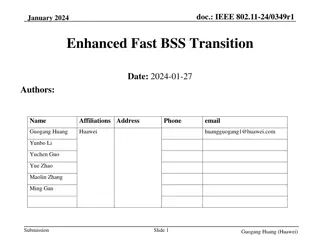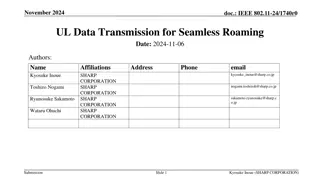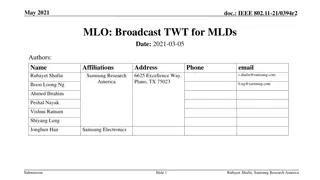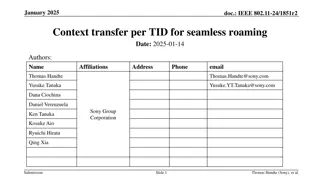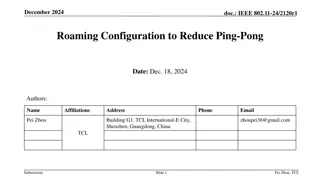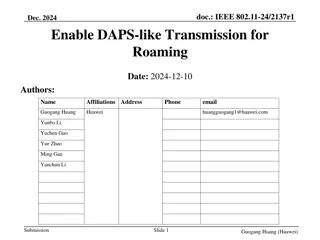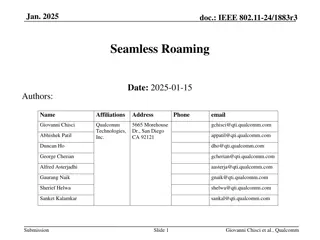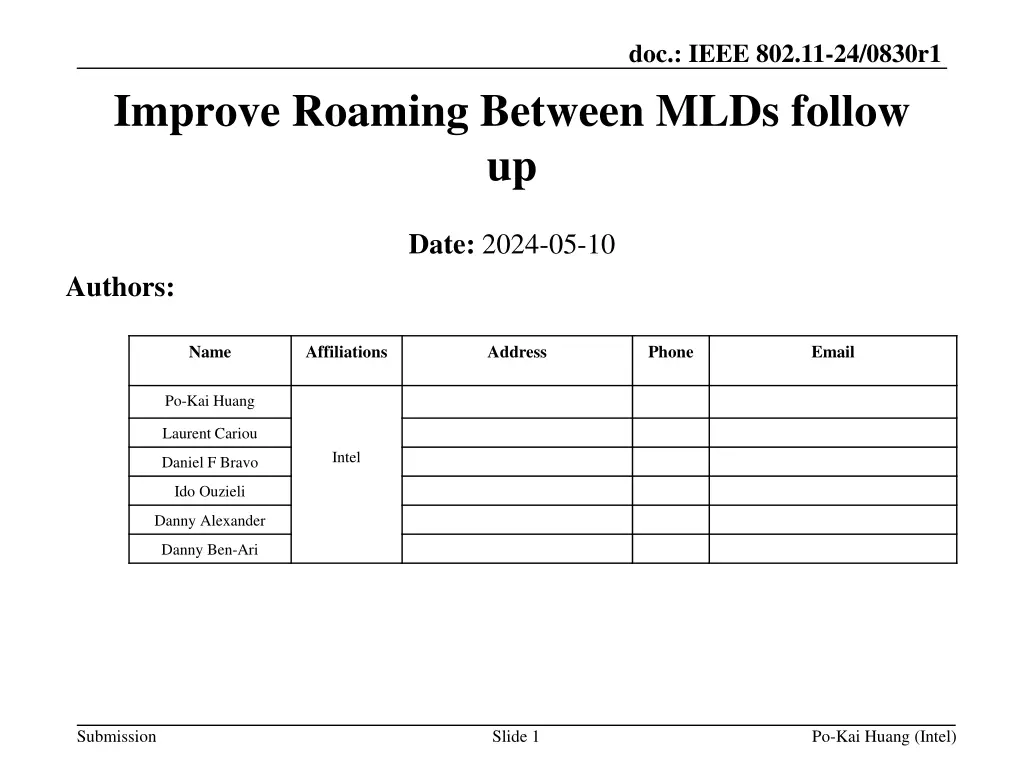
IEEE 802.11-24/0830r1 Roaming Improvement Proposal Explanation
This document discusses the proposal to enhance roaming between Mobile Link Directories (MLDs) in IEEE 802.11 networks, aiming to maintain data exchange continuity with minimal disruption and overhead. The focus is on minimizing data loss during roaming by optimizing message exchanges and context transfer between access points. It details the operational flow, addressing practical challenges and solutions for efficient roaming in 11bn networks while avoiding unnecessary overhead. The emphasis is on exchanging class 3 frames between AP MLDs and transferring Block Ack parameters to streamline the roaming process.
Download Presentation

Please find below an Image/Link to download the presentation.
The content on the website is provided AS IS for your information and personal use only. It may not be sold, licensed, or shared on other websites without obtaining consent from the author. If you encounter any issues during the download, it is possible that the publisher has removed the file from their server.
You are allowed to download the files provided on this website for personal or commercial use, subject to the condition that they are used lawfully. All files are the property of their respective owners.
The content on the website is provided AS IS for your information and personal use only. It may not be sold, licensed, or shared on other websites without obtaining consent from the author.
E N D
Presentation Transcript
doc.: IEEE 802.11-24/0830r1 Improve Roaming Between MLDs follow up Date: 2024-05-10 Authors: Name Affiliations Address Phone Email Po-Kai Huang Laurent Cariou Intel Daniel F Bravo Ido Ouzieli Danny Alexander Danny Ben-Ari Submission Slide 1 Po-Kai Huang (Intel)
doc.: IEEE 802.11-24/0830r1 Abstract We have agreed on the framework of roaming Maintain state 4 with only one AP MLD before and after roaming There have been many presentations, and the main improvement is to be able to continue the data exchange without extra overhead and disruption [1-8] Avoid additional message exchange Minimize DL data loss due to roam to another AP MLD Minimize UL data loss due to roam to another AP MLD We provide follow up in this presentation to explain how to achieve above in 11bn Submission Slide 2 Po-Kai Huang (Intel)
doc.: IEEE 802.11-24/0830r1 Flow of operation It has been pointed out [1, 6] that it is impractical to assume that we can have parameter sync among two AP MLDs or data from a central buffer that holds every data for every non-AP MLDs to each specific AP MLDs Hence, direct extension of MLD is not practical for all the scenarios The most practical approach is still to connect to one AP MLD at a time and have DS transfer Data to a specific AP MLD at a time Proposal: In 11bn when a non-AP MLD is not in the process of roaming initiated by the non-AP MLD and the non-AP MLD is in state 4, the non-AP MLD is allowed to exchange class 3 frames with only one AP MLD Based on the current spec, moving from current AP MLD to target AP MLD requires one message exchange of reassociaton request/response so that DS can be notified on the DS mapping change. The new AP notifies the DS at the completion of the reassociation so that the destination mapping for that non- AP STA s address is updated. In 11bn, we likely need to build our enhancement based on the message exchange that initiates notification of DS mapping change Technically, any frame can be used/reused to achieve this purpose, and we describe the operation to achieve our goal in high level Submission Slide 3 Po-Kai Huang (Intel)
doc.: IEEE 802.11-24/0830r1 How to avoid extra overhead If the client already has existing BA agreements for a TID, then those BA agreements should not be required to renegotiate after roaming Renegotiate BA agreements requires extra overhead To continue the BA agreement, contexts of BA parameters like Block Ack Parameters and Block Ack Timeout Value indicated by non-AP MLD can be transferred to the target AP MLD during the message exchange to initiate DS mapping change This illustrates why context transfer is useful Submission Slide 4 Po-Kai Huang (Intel)
doc.: IEEE 802.11-24/0830r1 How to minimize DL Data Loss If we have to wait for all the DL data to be finished on the current AP MLD before moving to the target AP MLD, then the waiting time maybe forever What if the DS just keeps forwards data to current AP MLD? Data Transfer between MLDs can not be mandated or guaranteed due to potentially huge number of data A more practical approach is to allow a transient period after DS notification of mapping change to receive remaining data from current AP MLD During this transient period, non-AP MLD may receive data from both current AP MLD and Target AP MLD It makes more sense to continue to use one receive reordering buffer rather than maintain two buffers only during the transient period, which requires extra cost. Hence, context transfer to target AP MLD on next SN to be assigned during the exchange for DS mapping change Example for DL only: Roam with DS mapping notification End of roaming procedure Current AP MLD Target AP MLD Current AP MLD Target AP MLD Current AP MLD Target AP MLD Non-AP MLD Non-AP MLD Non-AP MLD State 4 State 4 Submission Slide 5 Po-Kai Huang (Intel)
doc.: IEEE 802.11-24/0830r1 How to minimize UL Data Loss Similarly to the consideration that DL data transfer can not be guaranteed, transfer of UL data from current AP MLD to target AP MLD also can not be guaranteed After DS mapping change, current AP MLD can not pass up data to DS, so before DS mapping notification, client can ask current AP MLD to either passes up all data even hole exists in receive reordering buffer or drop all data in received reordering buffer After DS Mapping notification, client can send data to target AP MLD Non-AP MLD can use implementation specific way to minimize the hole before initiating roaming. For example, non-AP MLD may not try to transmit all of data with already assigned SN before initiating roaming, and simply transmit the data to target AP MLD after the DS mapping change SN assignment maybe tied to the queue management, and to change the existing assigned SN could mean reestablish queue (extra delay) or flush of queue (loss of data) To allow the data in the queue with already assigned SN to continue to transmit to target AP MLD, we need context transfer of duplicate cache without BA agreement and latest SN that has been pass up for TID with UL BA agreement Roam with DS mapping notification End of roaming procedure Current AP MLD Target AP MLD Current AP MLD Target AP MLD Current AP MLD Target AP MLD Non-AP MLD Non-AP MLD Non-AP MLD State 4 State 4 Submission Slide 6 Po-Kai Huang (Intel)
doc.: IEEE 802.11-24/0830r1 Summary of Proposal Allow context transfer => already motioned Proposal: define in 11bn that when a non-AP MLD is in the process of roaming from one AP MLD to another AP MLD, the context related to the non-AP MLD is transferred to the other AP MLD such that it preserves the data exchange context for the non-AP MLD? Details of the context that can be transferred are TBD How to transfer the context is TBD. Build the enhancement on message exchange that initiates DS mapping change Proposal o Define a request frame sent by a non-AP MLD in state 4 to initiate the roaming procedure o The roaming procedure performs context transfer to the target AP MLD and changes the DS mapping from the current AP MLD to the target AP MLD o Define a response frame sent to the non-AP MLD to indicate readiness for the non-AP MLD to send class 3 frames to the target AP MLD o TBD on data transmission from non-AP MLD to current AP MLD during the request/response frame exchange o NOTE - What context is transferred is TBD. Proposal o At the time the response frame to initiate the roaming procedure is sent, the following shall be complete The non-AP MLD context that is required for resuming operation with the target AP MLD shall be transferred to the target AP MLD o After this request/response frame exchange to initiate the roaming procedure, If DS is not already notified about the update of the destination mapping for the non-AP MLD, DS is notified about the update of the destination mapping for the non-AP MLD o After DS is notified about the update of the destination mapping for the non-AP MLD, the current AP MLD shall not pass up any user data in the received reorder buffer to the next MAC process. o NOTE - What context is transferred is TBD. Submission Slide 7 Po-Kai Huang (Intel)
doc.: IEEE 802.11-24/0830r1 Summary of Proposal Define transient period to continue to receive DL data from current AP MLD => already motioned Proposal: after the request/response exchange that initiates notification of the DS mapping change from the current AP MLD to the target AP MLD, The current AP MLD may deliver buffered DL data frames for a TBD period of time. The non-AP MLD may retrieve buffered DL data frames from the current AP MLD The non-AP MLD may send UL data to target AP MLD. It is assumed that the target AP MLD is able to deliver data frames to non-AP MLD after the DS mapping change Enable essential context transfer to continue UL and DL operation Proposal: enable the following contexts to be transferred to target AP MLD to preserve the data exchange context for the non-AP MLD Block Ack Parameters and Block Ack Timeout Value indicated by the non-AP MLD for existing BA agreement of a TID Next SN to be assigned for DL individually addressed data frame of each TID Latest duplicate receiver cache for TID without BA agreement latest SN that has been pass up for TID with UL BA agreement TBD for other contexts TBD on the agreed buffer size with the target AP MLD Submission Slide 8 Po-Kai Huang (Intel)
doc.: IEEE 802.11-24/0830r1 Conclusion We discuss the flow of operation for roaming to achieve the following main goals of 11bn enhancement Avoid additional overhead Minimize DL data loss due to roam to target AP MLD Minimize UL data loss due to roam to target AP MLD We explain why context transfer to target AP MLD is essential to achieve the goals above and minimize implementation complexity on the non-AP MLD We also explain that the procedure can be built on top of one message exchange to initiate DS mapping change like today and any frames can be used/reused for this purpose Submission Slide 9 Po-Kai Huang (Intel)
doc.: IEEE 802.11-24/0830r1 SP #1 Do you support the following: Define a request frame sent by a non-AP MLD in state 4 to initiate the roaming procedure The roaming procedure performs context transfer to the target AP MLD and changes the DS mapping from the current AP MLD to the target AP MLD Define a response frame sent to the non-AP MLD to indicate readiness for the non-AP MLD to send class 3 frames to the target AP MLD TBD on data transmission from non-AP MLD to current AP MLD during the request/response frame exchange NOTE - What context is transferred is TBD. o o o o o Submission Slide 10 Po-Kai Huang (Intel)
doc.: IEEE 802.11-24/0830r1 SP #2 Do you support the following: At the time the response frame to initiate the roaming procedure is sent, the following shall be complete The non-AP MLD context that is required for resuming operation with the target AP MLD shall be transferred to the target AP MLD After this request/response frame exchange to initiate the roaming procedure, If DS is not already notified about the update of the destination mapping for the non-AP MLD, DS is notified about the update of the destination mapping for the non-AP MLD After DS is notified about the update of the destination mapping for the non-AP MLD, the current AP MLD shall not pass up any user data in the received reorder buffer to the next MAC process. NOTE - What context is transferred is TBD. o o o o Submission Slide 11 Po-Kai Huang (Intel)
doc.: IEEE 802.11-24/0830r1 SP #3 Do you support to enable the following contexts to be transferred to target AP MLD to preserve the data exchange context for the non- AP MLD? Block Ack Parameters and Block Ack Timeout Value indicated by the non-AP MLD for existing BA agreement of a TID Next SN to be assigned for DL individually addressed data frame of each TID Latest duplicate receiver cache for TID without BA agreement latest SN that has been pass up for TID with UL BA agreement TBD for other contexts TBD on the agreed buffer size with the target AP MLD Submission Slide 12 Po-Kai Huang (Intel)
doc.: IEEE 802.11-24/0830r1 Reference [1] 11-23-0322 UHR Improve Roaming between MLDs [2] 11-22-1910 Seamless Roaming for UHR [3] 11-24-101 MLD roaming [4] 11-23-0231 thoughts on seamless roaming under the non- collocated ap mld architecture [5] 11-23-0279 considerations on seamless roaming [6] 11-23-0324 roaming requirements [7] 11-23-0632 smooth roaming follow up [8] 11-23-1131 thoughts on seamless roaming [9] 11-24-679 Thoughts on Functionality and Security Architecture for UHR Seamless Roaming Submission Slide 13 Po-Kai Huang (Intel)

